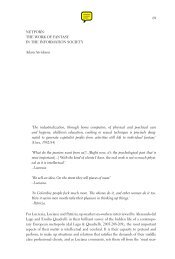Nakamura, Digitizing Race, Introduction, chapter 5, Epilogue
Nakamura, Digitizing Race, Introduction, chapter 5, Epilogue
Nakamura, Digitizing Race, Introduction, chapter 5, Epilogue
You also want an ePaper? Increase the reach of your titles
YUMPU automatically turns print PDFs into web optimized ePapers that Google loves.
26 <strong>Introduction</strong><br />
may not have known even existed. J. Lo’s readiness to fill different musical,<br />
national, and ethnic niches reflects the logic of the video and of the interface<br />
and its audiences; as she shifts from cornrowed hip-hop girl with baggy pants<br />
and tight shirts to high-heeled Latina diva to generic pop star with straightened<br />
hair and yoga pants, we see the movement as well between identities<br />
that characterizes her construction in this video as a digital media object of<br />
interactivity. She becomes an object of volitional ethnicity as she is constructed<br />
as an object of the user’s volitional mobility.<br />
Most importantly, this video walks the viewer through a process of digital<br />
racial formation; in a cut scene that functions as the transition to the<br />
world “inside” the interface that we see when it is clicked, shards and bits of<br />
gray confetti take flight past the viewer’s perspective to represent the way<br />
data is supposed to look. As this “white noise” resolves itself into a signal, a<br />
coherent visual image coalesces from these pieces of data into images of<br />
Jennifer Lopez dancing in the nationalized and racialized genre that the<br />
user has chosen, and we can see the formation of the colored and gendered<br />
body from undifferentiated pixels, at the pleasure of the viewer, and also the<br />
formation of the bodies of color, race, language, and nation as playing particular<br />
roles, performing particular work, in the context of new media. Like<br />
J. Lo, Filipino and Russian Internet “brides” are also clickable, women who<br />
can be randomly accessed via the Web. Their performances online are certainly<br />
different in kind and quality from that of the site’s designer or user:<br />
their job is to perform a kind of racialized submission, to the viewer’s interactive<br />
gaze and to the geopolitics that compel their digitized visual identity<br />
performance. In the case of the video, the cursor functions as a visual proxy<br />
that in this case stands in for the viewer; it is itself a kind of avatar and in<br />
recent times a televisual stylistic convention familiar to us in all sorts of contexts,<br />
used in PowerPoint presentations as well as in children’s programming,<br />
such as Dora the Explorer’s use of the computer cursor superimposed on the<br />
screen as a point of identification for children. Though Dora’s viewers can’t<br />
control the cursor, they can witness the cursor’s movements and implied<br />
user control, thus enforcing visual if not functional media convergence<br />
between the computer and the television. Sarah Banet Weiser’s work on Dora<br />
emphasizes the ways in which race is marketed as a “cool” way to help children<br />
learn language skills, one that hails Latino and other viewers of color<br />
in ambivalent, largely apolitical, and “postracial” ways. 34 Dora the Explorer<br />
depicts the Latina main character as an avatar who guides the child-viewer<br />
through the logic of the learning-game interface but does not stand in for<br />
the viewer herself: the Latina Dora is an object rather than a subject of





